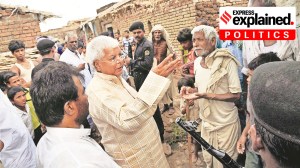The right way to manage water
Canal area is not growing. Almost the entire expansion of irrigation is from private investment in pumping water. Alternative styles of irri...

Canal area is not growing. Almost the entire expansion of irrigation is from private investment in pumping water. Alternative styles of irrigation are not spreading as fast as they should. Earlier methods of planning are not succeeding as they did then. This time we will sit with the sarkar on canal irrigation. Growth was around 1.5 million hectares annual earlier and is now around two lakh hectares. In the past when canal irrigation growth declined, special programmes were evolved and they worked. Now they don’t. The original Green Revolution planned by C. Subramaniam concentrated the hybrids on assured irrigated areas. After the first flush in the early Seventies foodgrain production was stagnating at around 100-103 million tonnes. Indira Gandhi demanded a fail-safe plan for food security. I headed the division of the Planning Commission, which mined district- village- and farm-level information for this purpose.
In early 1975 we said eight million hectares additional irrigation would take us to 125million tonnes of grain production by ’78/’79 and fertiliser consumption would reach 5 million tonnes. Fertiliser demand was down to 2.8 million tonnes after the oil price shock and the critics said the whole thing was harebrained. But the prime minister listened. After the budget, Rs 400 crore was allocated to complete eight major lingering projects. In two weeks time in April 1975 the project authorities knew their tasks. In 1979, back from Delhi, I remember telling one of the critics in Washington that our grain production was 127 million tonnes and fertiliser offtake 5.2 million tonnes since I was an Amdawadi and believed in building reserves in my targets. In the second half of the Eighties, the story was repeated. The droughts of ’86 and ’87 had drained Indian agriculture and grain production was again stagnating, now around 140 million tonnes. Rajiv Gandhi, not too happy at the negative tone of the appraisal of the Seventh Plan, turned it around and wanted “the last mile” to be covered before thenext crop season. We put in Rs 150 crore for reaching water to the field. Independent reviews in the nineties showed the plan worked.
In 1996 I was the planning minister. The humble farmer loved villages anywhere just as he loved his Karnataka. Water he knew was the key and his understanding of details was enormous. At the JNU when I was chairing the Cauvery Dispute Group, he would call me up to say that my facts on cane area in Mandya and Mysore were right but once the canal flows a minimum amount of water would have to flow even though their earlier demand was wrong. I love these calculations like little brothers but “your goodself” had to change them.
We convince the finance minister to start an Advanced Irrigation Benefit Programme. A quick note is prepared and as the budget said we wanted work to start soon. The rest is history. Four kinds of posturing were reported. Some people had a thinly-veiled agenda of working for one or the other interest group and their lobbying would delay the process.Second, the financewallahs would go to the press with quick fixes which would soon come unstuck. One day it was projects above Rs 500 crore; another day immediate benefits and so on. The third set of fellows was interesting and they had a refreshing approach born in the Nineties. They wanted to stop other people and were happy only if we were all poor. A particular chief minister would not send any proposals for his state but would spend all his time running down others. Finally Rs 500 crore out of the Rs 600 crore was allocated, but I was on my way out of Planning to Power. Last year Rs 952 crore was allocated and the approach paper says this is a Ninth Plan project, but neither the short- nor long-run objectives are known.
The agro-climatic people meanwhile found out that if there was a canal the highest priority amongst the farmers was to get the water to their field. In the national water project funded by USAID it was successfully demonstrated in a number of projects that this could be done. I went tosome of these villages: in Kaira, near Garh Muktheswar, in the Deccan. The farmer always complained there was not enough water to quench the insatiable thirst of his fields. But on closer questioning it would turn out that he did get water when earlier he did not. The so-called tail-ender problem was resolved. Delivery lines could be unclogged. Channels were completed and repaired, so were structures and regulators. Water scheduling was organised. The cost ranged between Rs 800 and Rs 3,000 per hectare and grudgingly the farmer was willing to give his mite. In many areas the solutions were ingenuous. A field at a higher elevation was wrongly included in the command, probably with political interference. The irrigation boys took spoilt cement bags, ponded the water and sent it to the field. Water literally flowed (went!) up the ridge. As, Pokharan shows, if the Indian is given a clear mandate and resources, he will perform.
The new government has been wrongly advised to give up the Advanced IrrigationBenefit Programme of the Central government by handing it to the state governments whatever that means in its interim budget. It is hoped they will come out with workable solutions in the budget, although a working season is already lost. On water management, an interesting possibility is to hand over the water to local cooperatives or even farmer-owned companies. Again the present experiments of this kind of reform are only for dams and main canals, the wrong end of the stick.



- 01
- 02
- 03
- 04
- 05




























